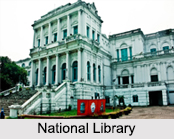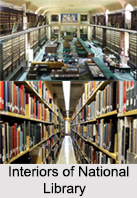 National Library is the first public library to be set up in the whole of eastern India. It is located on the Belvedere Road, Kolkata. It is an institution of national importance under the Ministry of Culture, Government of India. Being the capital of the British East India Company, Kolkata was the hub of all intellectual and academic activities. There were scholarly activities, which necessitated the formation of libraries. Though there was the Calcutta Public Library, it was actually run on proprietary basis. The National Library is an integrated form of the libraries that functioned independently in the British era. Today, the National Library is the biggest public library which has a collection of 22,70,954 books along with a huge collection of manuscripts, newspapers and periodicals.
National Library is the first public library to be set up in the whole of eastern India. It is located on the Belvedere Road, Kolkata. It is an institution of national importance under the Ministry of Culture, Government of India. Being the capital of the British East India Company, Kolkata was the hub of all intellectual and academic activities. There were scholarly activities, which necessitated the formation of libraries. Though there was the Calcutta Public Library, it was actually run on proprietary basis. The National Library is an integrated form of the libraries that functioned independently in the British era. Today, the National Library is the biggest public library which has a collection of 22,70,954 books along with a huge collection of manuscripts, newspapers and periodicals.
History of National Library
The library was not called the "National Library" earlier, but went through an evolution and merged with the public libraries and British Secretariat libraries into what it is known today as the "National Library". Earlier the libraries that run on donations, the public and other libraries did not function professionally. Like the Calcutta Public Library which had a unique position and whose first proprietor was Dwarkanath Tagore, the Library purchased both the Indian and foreign books especially from Britain. It was reported in 1850, that the Library started collecting books in Gujarati, Marathi, Pali, Punjabi as well as Ceylonese. Government of Bengal and North Western Provinces provided donations regularly to fund the working of the Library. This library had such rare collection that the National Library got benefited from it. There was also the Imperial Library, which was formed by combining a number of Secretariat Libraries. Hence there was no such composite body of Library, which could develop with better facilities. This instigated Lord Curzon to devise a plan to merge the Calcutta Public Library and the Secretariat Libraries of British East India into a single library called the “Imperial Libraryâ€. This Library was then renamed as the “National Library†under an enactment under the Imperial Library (change of name) Act 1948. This initiated the shifting of the whole collection to this present site of the Belvedere Road from the Esplanade.
 The National library was hence opened for the public on 1st February 1953, after an inauguration by Maulana Abul Kalam Azad. From then, the National library continues to be the cynosure for all literary pursuit going on in Kolkata and it keeps the tradition alive.
The National library was hence opened for the public on 1st February 1953, after an inauguration by Maulana Abul Kalam Azad. From then, the National library continues to be the cynosure for all literary pursuit going on in Kolkata and it keeps the tradition alive.
Collections of National Library
Going through the library shelves, one can find that there are exclusive divisions of Foreign and Indian language books and publications. Books, periodicals, journals and manuscripts of all the major Indian languages like Marathi, Gujarati, Kannada, Punjabi, Tamil, Telugu, etc. constitute the Indian language category. In the Sanskrit language division there are rare Pali and Prakrit manuscripts. The Foreign language division has been categorized into sections like German Division, East Asian Division, Roman Division, West Asia, Slavonic Division, and African Division, all of which are replete with collection of books and manuscripts. It is the storehouse of the rare collection of the Indian official documents from the early days of the British Colonial rule till the present day. The National Library has the honour of being a repository library by the United Nations and its agencies. This enables the National Library to receive all United Nations publications free of cost from them. It also receives books and periodicals from the government of the United States of America and all other commonwealth countries. One can also spot major Indian newspapers, and periodicals dated back to even 19th and 20th centuries.
The Rare Books Section comprises of books, monographs and manuscripts that date back to the pre 1860 era. The National Library not only has a remarkable stock of books and articles but is also such a medium, which is used as a link for correspondence with the past generations.
Visiting Information of National library
National Library is located on Belvedere Road in Alipore, Kolkata. It is open between 9 am and 8 pm on all working days and between 9.30 am and 6.00 pm on Saturdays, Sundays and Government of India holidays. It remains closed on 3 national holidays, 26th January (Republic Day), 15th August (Independence Day) and 2nd October (Birthday of Mahatma Gandhi).



















